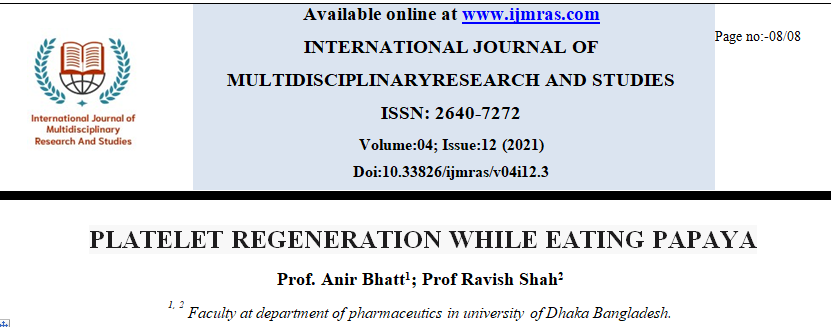A PLATELET REGENERATION WHILE EATING PAPAYA

Abstract
The different corridor of the Papaya (Carica papaya Linn.) belonging to the family Caricaceae similar as leaves, seeds, latex, and fruit retain excellent medicinal parcels for the treatment of different affections. The stem, splint, and fruit of papaya contain plenitude of latex. The latex from callow fruit contains the enzyme papain, other factors include admixture of cysteine end peptidases, chitinases, and an asset of serine protease, alkaloids, glycosides, flavanoids, saponins, tannins, phenols, and steroids. This evaluation focuses on the nutritive merit, phyto-chemical component, tocopherol and free comprehensive scavenging exertion, medicaments for dengue fever, and anticancer exertion of paw-paw. Papaya acts as an amulti-faceted factory. It's also essential to identify the medium of the factory composites and study the active principle of the excerpt. It's proposed to involve the paw-paw in our diet as fruit mixed greens, fruit sap, splint excerpt, a decoction prepared through paw-paw leaves, etc.(31)
Keywords
Carica Papaya Linn; Benefits; Tocopherol (antioxidents; Regenration; Blood Platele; and Free Comprehensive (radical)Scavenging;How to Cite
References
Nakasone HY, Paull RE. Tropical Fruits. CAB International, Wallingford, England, 1998;445.
Du Puy DJ, Telford IRH. Caricaceae. Chapter 30: In Flora of Australia, Oceanic Islands 2. Australian Government Publishing Service,
Canberra, Australia, 1993; 50: 163-164.
Arumuganathan K, Earle ED. Nuclear DNA content of some important plant species. Plant Mol. Biol. Rep, 1991; 9(3): 208-218.
Bennett MD, Leitch IJ. Nuclear DNA Amounts in Angiosperms: Progress, Problems, and Prospects. Ann Bot, 2005; 95(1): 45-90.
Bruneton J. Carica papaya, In Pharmacognosy, phytochemistry of medicinal plants, Tech Docu Fra, 1999; 2: 221-223.
The Wealth of India-A dictionary of Indian raw materials and industrial products: Raw material series, Ca-Ci, publications and
information directorate, CSIR, 1992; 3: 276-293.
Nadkarni KM. Indian material medica, Pop Pra Pvt Ltd, Bombay, 1954; 1: 273-277.
Vijay Y, Pradeep KG, Chetan CS, Anju G, Bhupendra V. Carica papaya Linn: An Overview. Int. j. herb. Med, 2014; 2(5): 1-08.
Philip T, Chen TS. Quantitative analyses of major carotenoid fatty acid esters in fruits by liquid chromatography: Persimmon and
Papaya. J. Food Science, 1988; 53(6): 1720-1722.
National Institutes of Health (NIH) Carotenoid analyses of U.S. foods, Food Composition Laboratory, 1997.
Franke AA, Suzanne M, Lacey R, Custer LJ. Tocopherol and tocotrienol levels of foods consumed in Hawaii, J Agric Food Chem, 2007;
(3): 769-778.
Produce Marketing Association (PMA). Nutrient Content of Papaya, 1984.
Nutrient Data Laboratory, ARS, USDA National Food and Nutrient Analysis Program Wave 12i, 2008 Beltsville MD.
Vollendorf N, Marlett J. Comparison of Two Methods of Fiber Analysis of 58 Foods. J. Food Comp. Anal, 1993; 6(3): 203-214.
Mahattanatawee K, Manthey JA, Luzio G, Talcott ST, Goodner K, Baldwin EA. Total antioxidant activity and fiber content of select
Florida-grown tropical fruits, J Agric Food Chem, 2006; 54(19): 7355-7363.
Wall MM. Ascorbic acid, vitamin A, & mineral composition of banana & papaya cultivars grown in Hawaii. J. Food Comp. Anal, 2006;
(5): 434-445.
Lako J, Trenerry VC, Wahlqvist M, Wattanapenpaiboon N, Sotheeswaran S, Premier R. Phytochemical flavonols, carotenoids and the
antioxidant properties of a wide selection of Fijian fruit, vegetables, and other readily available foods. Food Chemistry, 2007; 101:
-1741.
Miller-Ihli NJ. Atomic absorption and atomic emission spectrometry for the determination of the trace element content of selected
fruits consumed in the United States. J. Food Comp. Anal, 1996; 9(4): 301-311.
Franke AA, Custer LJ, Arakaki C, Murphy SP. Vitamin C and flavonoid levels of fruits and vegetables consumed in Hawaii. J. Food
Comp. Anal, 2004; 17: 1-35.
Philip T, Chen TS. Development of a method for the quantitative estimation of provitamin A carotenoids in some fruits. J. Food Sci,
; 53(9): 1703-1707.
Humphries JM, Khachik F. Distribution of lutein, zeaxanthin, & related geometrical isomers in fruit, vegetables, wheat, & pasta
products. J Agric Food Chem, 2003; 51(3): 1322-1327.
Horn-Ross PL, Barnes S, Lee M, Coward L, Mandel E, Koo J, John EM, Smith M. Assesing phytoestrogen exposure in epidemiologic
studies: development of a database (United States)., Cancer Causes Control, 2000; 11(4): 289-98.
Zhou K, Wang H, Mei W, Li X, Luo Y, Dai H. Antioxidant activity of papaya seed extracts. Molecules, 2011; 6(8): 6179-6192.
Webman EJ, Edlin G, Mower HF. Free radical scavenging activity of papaya juice. Int J RadiatBiol, 1989; 55(3): 347-351.
Mehdipour S, Yasa N, Dehghan G, Khorasani R, Mohammadirad A, Rahimi R, Abdollahi M. Antioxidant potentials of Iranian Carica
papaya juice in vitro and in vivo are comparable to alpha-tocopherol. Phytother Res, 2006; 20(7): 591-594.
Okoko T, Ere D. Reduction of hydrogen peroxide-induced erythrocyte damage by Carica papaya leaf extract. Asian Pac J Trop
Biomed, 2012; 2(6): 449-453.
Pandey VP, Singh S, Singh R, Dwivedi UN. Purification and characterization of peroxidase from papaya (Carica papaya) fruit. Appl
BiochemBiotechnol, 2012; 167(2): 367-376.
Li ZY, Wang Y, Shen WT, Zhou P. Content determination of benzyl glucosinolate and anti-cancer activity of its hydrolysis product in
Carica papaya L. Asian Pac J Trop Med, 2012; 5(3): 231-233.
Nakamura Y, Yoshimoto M, Murata Y, Shiraishi Y, Asai Y, Park EY, Sato K, Nakamura Y. Papaya seed represents a rich source of
biologically active isothiocyanate. J Agric Food Chem, 2007; 55(11): 4407-4413.
Halliwell B, Aeschbach R, Löliger J, Aruoma OI. The characterization of antioxidants. Food Chem Toxicol, 1995; 33(7): 601-617.
Source
License
Copyright (c) 2021 IJMRAS

This work is licensed under a Creative Commons Attribution 4.0 International License.
Individual articles are published Open Access under the Creative Commons Licence: CC-BY 4.0.




